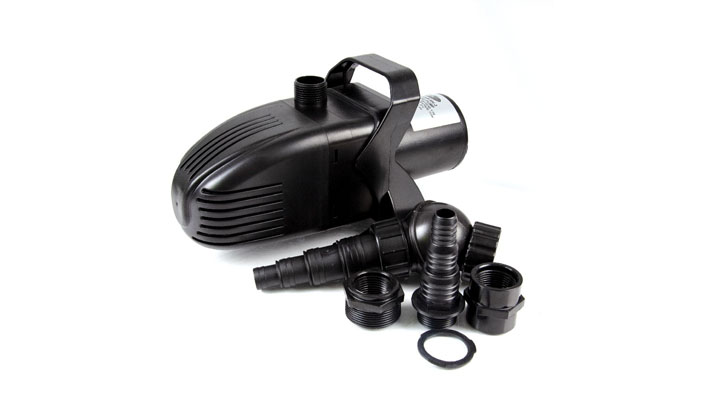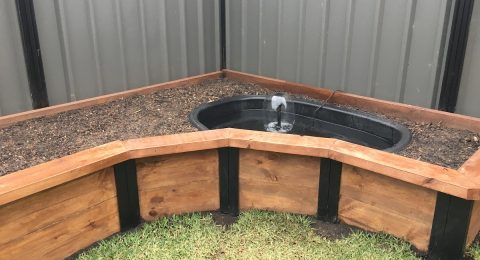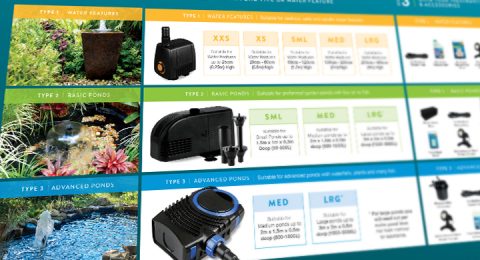
Submersible Pumps
Learn how to choose the right submersible pond pump for your situation.
The pond pump is the heart of your garden. With this in mind, it is very important to get it right. Pumps vary enormously in design and function and with this the price also varies accordingly so it is important to know the difference.
Water Feature & Small Pond Pumps
Small pumps only, often used in fountains, hydroponic reservoirs and Waterfeatures.
Fountain Pumps
Suitable for garden ponds, usually come with an array of different fountain nozzles and a tee piece arrangement to run a waterfall or cascade at the same time. Fountain pumps have a pre-filter cage sponge to avoid particles from jamming the pump and blocking nozzles. These pumps should be mounted off the bottom of the pond, e.g. on a brick.
Correct Flow And Pump Head Height
In order to choose the right pump for your pond you will need to identify both (a) the flow rate and (b) the head height or pressure on the pump. This information is usually on the pump box. The manufacturer will state the maximum flow and the maximum head. This does not mean you will get the maximum flow at the maximum head height. The maximum flow is the volume of water from the pump with no hose attached. The maximum head is the height the water will reach when there is zero flow. i.e.: max head X litres per hour.
Reliability
A pond pump is an amazing appliance. It not only pumps in a harsh environment but has to run 24 hours a day, 365 days a year. So when choosing a pump you need to be sure it will last and not let you down. Remember that the memory of inferior quality lasts longer than the brief joy of a cheap price. For your peace of mind you should make sure the pump is backed with a warranty and that spare parts are available. A product with a longer warranty will have a better track record for reliability and will indicate the confidence of the manufacturer in its quality.
Power consumption
With your pond pump working all day every day the cost to run it is an important factor to consider. All pumps have the wattage stated on the packaging and the unit. To work out how much your pump costs, use the below formula to calculate the approximate cost of running your pump 24hrs a day, 365 days a year.:
Wattage x 2.5 = Approx Yearly Cost $ (running 24 hours/365 days)
Example
100 watts x 2.5 = $250.00 to run per year
Sump Pumps
Sump pumps are inexpensive pumps used for draining ponds and transferring water. They are bottom suction and mostly come with a float switch. Sump pumps are inefficient in terms of electricity consumption and are often ”non continuous” and for short intermittent pumping.
-
The Golden Rule!
Unsure if the pump is of adequate strength/flow? Choose the next size up.
How to calculate what you need
-
Step 1 Calculating Flow
To determine the correct flow you will need the pond volume. The entire volume of water in a pond should be pumped through a bio-filter every 1-2 hrs minimum depending on pond size and depth. For Koi ponds it is recommended the rate be increased to every hour.
Example
Standard Pond
2,000 litres = pump 1,000-2,000 litres per hour
Koi Pond
2,000 litres = pump 2,000 litres per hour
You also need to factor in the flow rate.
-
Step 2 Calculating Head
To calculate the required head height, simply measure or estimate the maximum total height that your pump must move water to.
Make sure you have remembered to add the head required to run biofilter.
-
Step 3 Choosing the Right Pump
Once you have the maximum head and the total flow you require, you will need to choose a pump that can operate at the required head height and flow rate.
Example
Required Flow
= 3,000 litres per hour
Required Head
= 2 metres
Flow from Pump at 2.00m high
= 3,100 litres per hour



